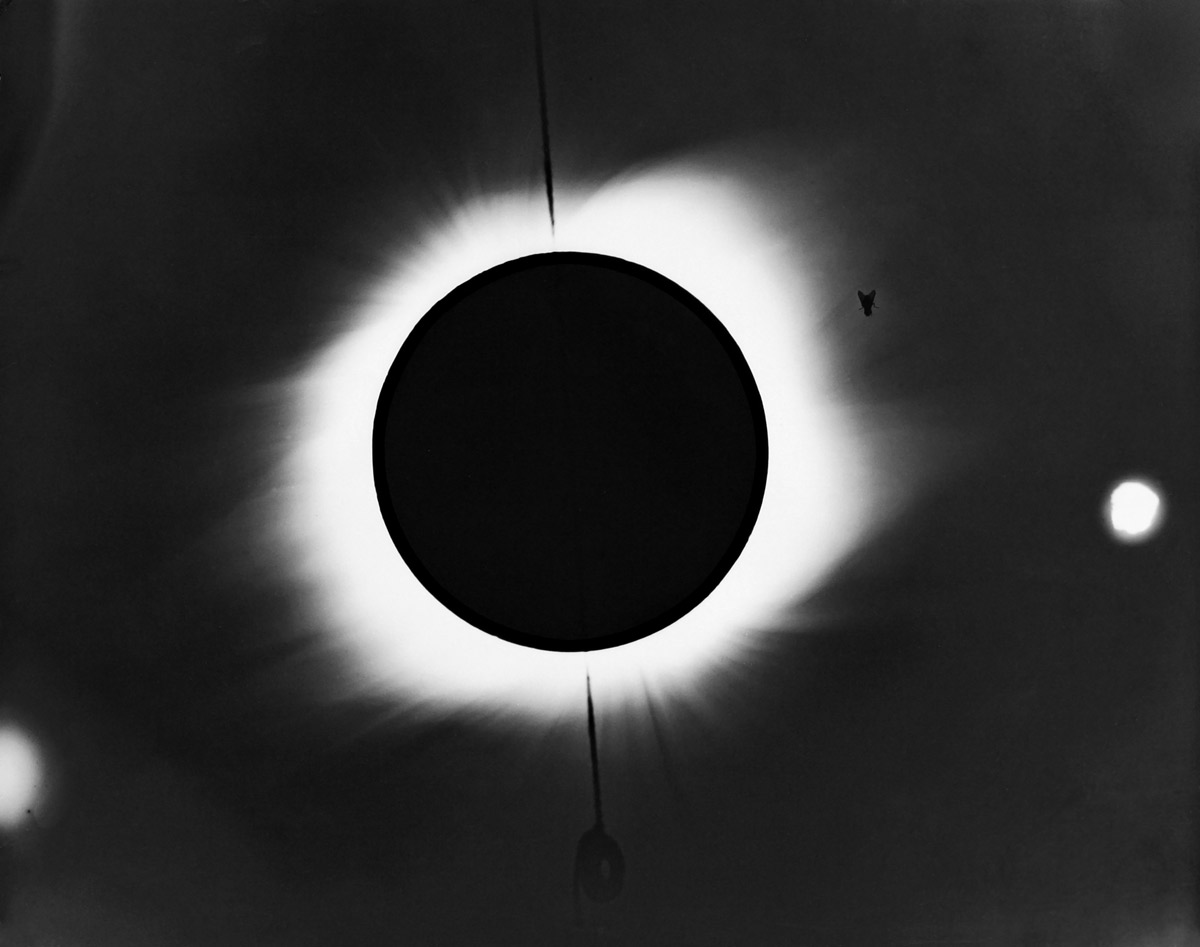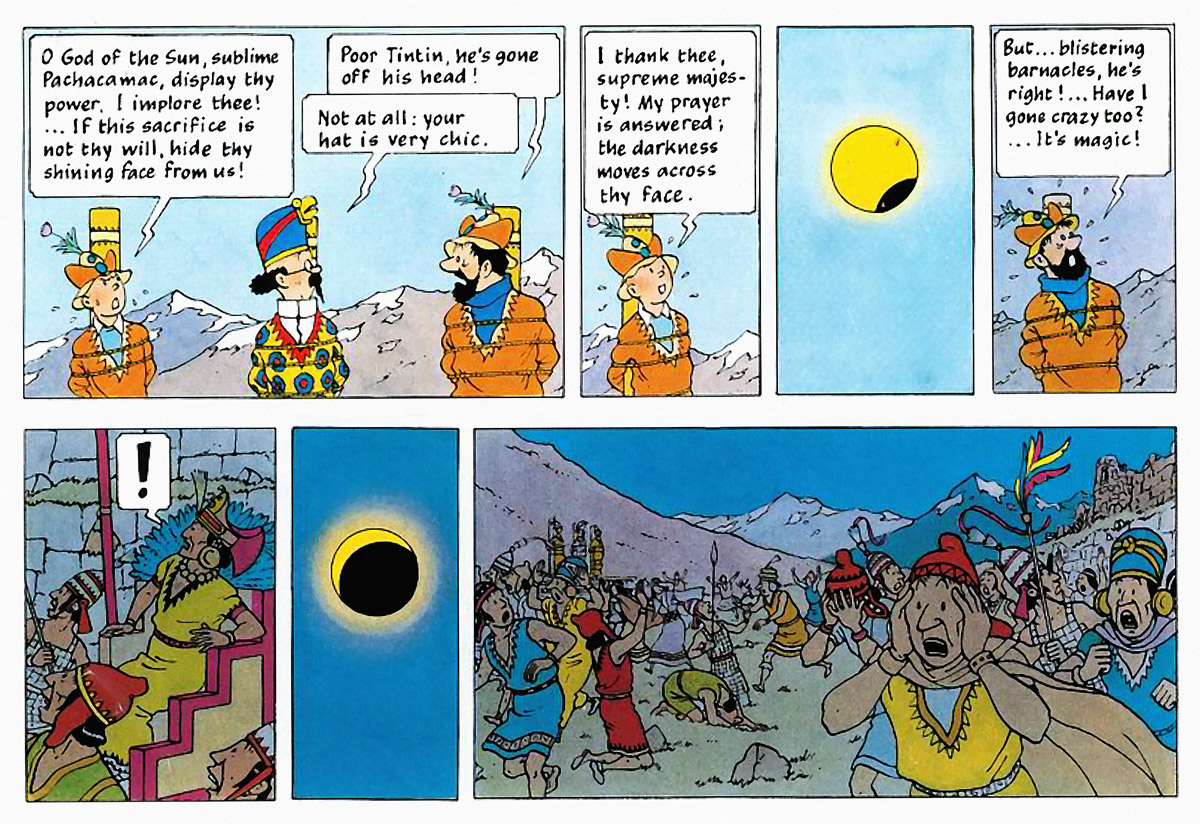Light Devoured
From surrogate kings to sun shields
Mats Bigert

When Tintin is captured by an ancient Inca tribe in his fourteenth adventure, Prisoners of the Sun, he finds an article on his cell floor that forecasts a coming solar eclipse. This will prove to be significant since he, Captain Haddock, and Professor Calculus are to be burned at the stake. Tintin manages to see to it that the execution is staged at the right moment. When the Inca Prince of the Sun orders the pyre to be lit, Tintin invokes the Sun God: “O God of the Sun, sublime Pachacamac, display thy power, I implore thee! … If this sacrifice is not thy will, hide thy shining face from us!” In this patronizing Occidental fable of mathematical calculation triumphing over traditional belief, the weather god gives way to the scientist, whose knowledge gives Tintin the power to produce an apparent miracle.
The scientist who made such exact prognostications possible was the German astronomer Johannes Kepler. In 1600, he was hired as an assistant by the Danish astronomer Tycho Brahe and was given the painstaking task of analyzing observations of Mars made by Tycho and compiling them into a new set of astronomical tables. The aim was to improve on the Copernican tables published in 1543, the first to propose a heliocentric worldview with planets orbiting the sun in circular paths. But after nearly four years of work under miserable conditions—Kepler was constantly sick and suffered from double vision in one eye, among other things—he could not get Tycho’s calculations to add up. (Tycho himself had died in 1602.) He tried using the Copernican model but there were inexplicable discrepancies between that and real observations. Then, in 1604, having almost given up, he finally came to the idea that the planets might be moving not along circular but, rather, elliptical paths, and at varying speeds. The further away from the sun, the slower the speed. Kepler published his findings in 1609 in his Astronomia Nova (New Astronomy); his revolutionary “Rudolphine Tables,” named after the Holy Roman emperor who had commissioned the undertaking, appeared in 1627. These tables could be used to forecast the positions of the planets at any given moment some fifty times more accurately than had previously been the case, which in turn made it possible not only to forecast solar and lunar eclipses with minute precision but also to reconstruct such events in the past. Kepler’s discovery meant that the date of any event whose historical record connected it to a celestial event could now be calculated with unprecedented exactitude.
Many cultures have traditionally viewed eclipses as bad omens that brought famine, disease, and death in their umbral wake. Rulers of ancient civilizations went to great lengths trying to predict them and to perform counter-magic to mitigate the risk of being struck down by an ecliptic curse. During the neo-Assyrian empire (8th–7th century BC), the ritual of the šar pūhi, or “substitute king,” was a common practice for protecting the ruler from angry gods during both solar and lunar eclipses, which court astronomers of the period could calculate with some degree of accuracy. If all the various portents suggested that the coming eclipse presented a threat to the ruler, the real king was taken away, and another man, dressed up in royal clothes and appropriate regalia, was placed on the throne so that he would instead become the recipient of the unwelcome destiny awaiting the king. Then, when the period of danger following the eclipse—sometimes believed to last as long as a hundred days—was deemed to have passed, the real king was reinstated and the substitute king executed.[1]

Was it a substitute Donald Trump, then, who appeared on the White House’s Truman Balcony on 21 August 2017? As he was photographed looking straight into the ongoing eclipse, the risk of damage to his eyes, and of potential blindness, was apparent. In this fable, the substitute king will not lose his life but his capacity to see, and the audience’s gaze is thereby diverted from the political chicanery happening in the shadows. The triple blindness of this event—the moon covering the sun; the frying retina of the man on the balcony; and the general blackout of the public’s attention—offers an allegory for the intersecting trajectories of empirical enlightenment science and the dark forces of alternative facts.
The obscuring of the fossil fuel industry’s responsibility for its role in global heating could serve as one example of this intersection. In the spirit of Kepler, climate scientists employed by Exxon developed in 1981 one of the first climate-modeling computer programs, which predicted how continued use of fossil fuels would cause drastic climate change.[2] The findings were at odds with Exxon’s financial objectives, and its executives launched a decade-long campaign to sow doubt about the correlation the company itself had modeled. The company did this not only through public media, such as advertisements; it also paid climate experts to infiltrate scientific debates with only one motive—to foster uncertainty. Ironically, the systems first developed by the Exxon scientists in the early 1980s have now evolved into the global and regional climate models used by most scientists working in the field. These are instruments that allow us to understand the scenarios we can expect in the future, mathematically describing the interaction between the climate’s various components, such as the atmosphere, seas, land, and ice.
One component that is particularly hard to calculate is the effect of cloud cover on the climate, because clouds are complex, relatively small scale, and difficult to model. Our modern computers are not powerful enough to include clouds in large-scale calculations, and it may be another ten years before there are machines that can do so. Clouds can both protect against incoming solar radiation and contribute to the greenhouse effect. Low, thick clouds, such as stratocumulus, reflect solar radiation and cool the earth’s surface, while high, thin clouds let the radiation through but absorb outgoing heat, thus warming up the atmosphere. Scientists are not completely united on the degree to which clouds affect the climate, but a recent study of the Paleocene–Eocene Thermal Maximum, which occurred roughly fifty-six million years ago, has revealed the complex relationship between stratocumulus clouds and the surprising six-degree Celsius rise in the earth’s temperature that occurred during the event.[3] Modeling by scientists at the California Institute of Technology suggests that a rise in global temperature levels increased turbulence inside stratocumulus clouds, while reducing the extent to which the now-warmer upper atmosphere could cool the tops of these clouds. The two factors combined to prevent stratocumulus from forming, and the absence of these low clouds in turn further contributed to global heating during the period, which saw sea levels rise significantly as a result of glacial melting. But this is not considered a mass extinction event; it occurred over the course of three hundred thousand years, which gave all land animals and plants plenty of time to migrate and adapt. Today’s climate change is occurring much faster, and when the red line of the thermometer climbs and the flood waters come, no one will have time to move.
In one of J. G. Ballard’s first novels, The Drowned World, published in 1962, only a shrivel of mankind is still alive in a flooded delta below which lies their submerged civilization. As the nature around the lagunas on top of London begins to take on Mesozoic-like form, with enormous alligators and gigantic lizards inhabiting small seaweed-covered islets, the people in the novel also embark on a “devolutionary” psychic trip. Dr. Kerans, a biologist left behind in a leaking lab, soon starts to dream abstract prehistoric nightmares. And as civilization boils off under the blistering sun, reason itself is also dissolved and jettisoned back into the depths of a primordial state of mind.
But even in a sun-scorched future without clouds, solar eclipses will still occur. The shadow presented by the moon during those rare events will offer little comfort, however, when it comes to global heating at large, even though the thermal shift during the two to three minutes of an eclipse is exceptional. During the eclipse in Lusaka, Zambia, on 21 June 2001, NASA measured an instant drop of nearly 8° Celsius in the air temperature.[4] So, what if humans were to conjure up a large-scale eclipse scheme that could shade large parts of the world’s sweltering heat islands?
Some of the speculative proposals for the management of solar radiation include giant space mirrors, lenses, or clouds of particles sprayed into the earth’s atmosphere. But the most radical idea in this geo-engineering field involves a collaboration with the moon itself. The “sun shield,” the brainchild of Curtis Struck, a professor of astronomy at Iowa State University, is a proposal to create a protective cosmic blanket made out of dust mined from the moon itself. “Lunar dust particles are just the right size to scatter sunlight,” according to an article describing Struck’s scheme.[5] “If the particles are injected at two precise positions along the Moon’s orbit, they will form a pair of stable clouds that would each pass in front of the Sun once a month, blocking sunlight for about 20 hours each month.”
How these orbital shade clouds are to be generated is not exactly clear, but if these regions of hazy particles were able to be gathered, they could then be directed out to the first Lagrangian point, a place in space between the sun and the earth where gravitational pull is in equilibrium.[6] Positioned 1.5 million kilometers above our heads, the large white reflective veil would create a constant dimming effect, or an eternal lightweight eclipse.
And so man-made clouds are offered as the remedy that will save us from death by sunstroke. But the artificial eclipses dreamed up by mad scientists will be nothing like the extraordinary cosmic event that is a real solar eclipse. Unfortunately, these mesmerizing natural phenomena are also, like clouds, threatened with extinction. Due to centrifugal forces and a subsequent loss in the gravitational pull that our planet exerts on its satellite, the moon is receding from the earth by 3.8 centimeters every year—a slow-motion goodbye that eventually, 680 million years into the future, will leave a moon disc too small to cover the sun in its totality.
- For more on this custom, see Jean Bottéro, Mesopotamia: Writing, Reasoning, and the Gods, trans. Zainab Bahrani and Marc Van De Mieroop (Chicago: University of Chicago Press, 1992), pp. 138–155. See also Guillermo Carvajal, “How Sumerians Named Substitute Kings during Eclipses and the Custom Survived Even in Alexander’s Time,” La Brújula Verde, 23 September 2020. Available at labrujulaverde.com/en/2020/09/how-sumerians-named-substitute-kings-during-eclipses-and-the-custom-survived-even-in-alexanders-time.
- Phoebe Keane, “How the Oil Industry Made Us Doubt Climate Change,” BBC.com, 19 September 2020. Available at bbc.com/news/stories-53640382.
- Natalie Wolchover, “A World without Clouds,” Quanta Magazine, 25 February 2019. Available at quantamagazine.org/cloud-loss-could-add-8-degrees-to-global-warming-20190225.
- “Temperature Change during Totality,” NASA.gov. Available at eclipse2017.nasa.gov/temperature-change-during-totality.
- “Keep Earth Cool with Moon Dust,” New Scientist, 9 February 2007. Available at newscientist.com/article/dn11151-keep-earth-cool-with-moon-dust.
- For more on the first Lagrangian Point, see esa.int/Science_Exploration/Space_Science/L1_the_first_Lagrangian_Point.
Mats Bigert is one half of the Swedish artist duo Bigert & Bergström, whose artistic practice spans from large-scale sculptures and installations to performance and film. The duo is known for their analysis of scientific and social issues, in particular their work on weather and climate change. They recently collaborated with the Climate Impacts Research Centre at Umeå University to produce their latest work, “Sensing the Arctic,” a land art project situated on a mire north of the Arctic Circle in Abisko, Sweden.
Spotted an error? Email us at corrections at cabinetmagazine dot org.
If you’ve enjoyed the free articles that we offer on our site, please consider subscribing to our nonprofit magazine. You get twelve online issues and unlimited access to all our archives.